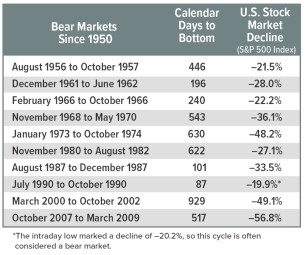Turbulent Times: Bear Markets Come and Go
The longest bull market in history lasted almost 11 years before coronavirus fears and the realities of a seriously disrupted U.S. economy brought it to an end.1
Bear markets are typically defined as declines of 20% or more from the most recent high, and bull markets are sustained increases of 20% or more from the bear market low. But there is no official declaration, so often there are different interpretations and a fair amount of debate regarding when these cycles begin and end.
Between February 19 and March 23, 2020, the S&P 500 fell 34% and then took just 15 days to bounce back above the 20% threshold that would technically mark the beginning of a new bull market.2
Still, most investors wait to see if volatility subsides and higher prices persist before they cheer the exit of a bear market. And in the midst of the pandemic, without a clear economic picture, it could be more difficult than usual to tell whether any market advance is a short-term rally or the start of a longer upward trend.
Historical Perspective
The CBOE Volatility Index (VIX), a closely watched measure of stock market volatility and investor anxiety, hit all-time highs in March 2020.3
If you are losing sleep over volatility driven by disheartening news, it may help to remember that the economy and the stock market are cyclical. There have been 10 bear markets since 1950 (not counting the one that began in 2020). Each of these declines was triggered by a different set of circumstances, but the market recovered eventually every time (see table). 4
On average, bull markets lasted longer (1,955 days) than bear markets (431 days) over this period, and the average bull market advance (172.0%) was greater than the average bear market decline (-34.2%).
The bottom line is that neither the ups nor the downs last forever, even if they feel as though they will. There are buying opportunities in the midst of the worst downturns. And in some cases, people have profited over time by investing carefully just when things seemed bleakest.

Making Changes
If you're reconsidering your current investment strategy, a volatile market is probably the worst time to turn your portfolio inside out. Dramatic price swings can magnify the impact of a wholesale restructuring if the timing of that move is a little off.
Changes in your portfolio don't necessarily need to happen all at once. Having appropriate asset allocation and diversification is still the fundamental basis of thoughtful investment planning, so try not to let fear derail your long-term goals.
The return and principal value of stocks fluctuate with changes in market conditions. Shares, when sold, may be worth more or less than their original cost. Asset allocation and diversification are methods used to help manage investment risk; they do not guarantee a profit or protect against investment loss.
The S&P 500 is an unmanaged group of securities that is considered to be representative of the U.S. stock market in general. The performance of an unmanaged index is not indicative of the performance of any specific investment. Individuals cannot invest directly in an index. Past performance is not a guarantee of future results. Actual results will vary.
1-2,4) Yahoo! Finance, 2020 (data for the period 6/13/1949 to 4/7/2020)
3) MarketWatch, March 31, 2020
Content provided by Forefield for use by Eliot M. Weissberg, CFP®, CFS, of Raymond James Financial Services, Inc., Member FINRA/SIPC. The Investors Center, Inc. is an independent company. The information contained in this report does not purport to be a complete description of the securities, markets, or developments referred to in this material. The information has been obtained from various sources considered to be reliable, but we do not guarantee that the foregoing material is accurate or complete. Any opinions are those of Eliot Weissberg and not necessarily those of RJFS or Raymond James. Expressions of opinion are as of this date and are subject to change without notice.
This information is not intended as a solicitation or an offer to buy or sell any security referred to herein. Past performances may not be indicative of future results. You should discuss any tax or legal matters with the appropriate professional.
M20-3119972 through 6/9/21


